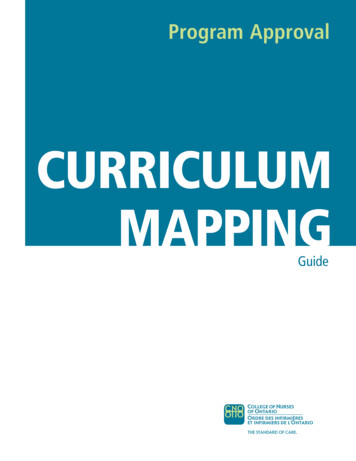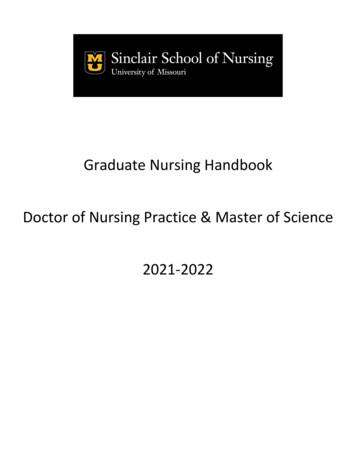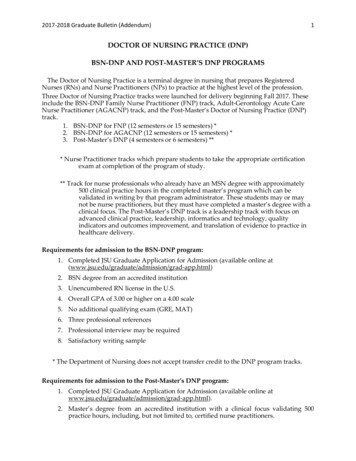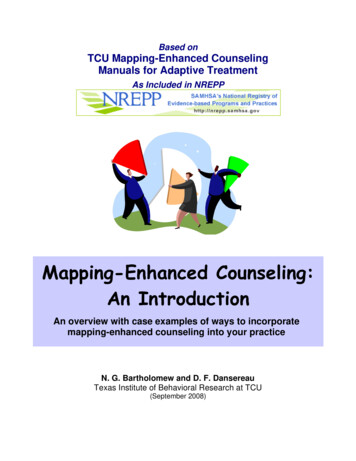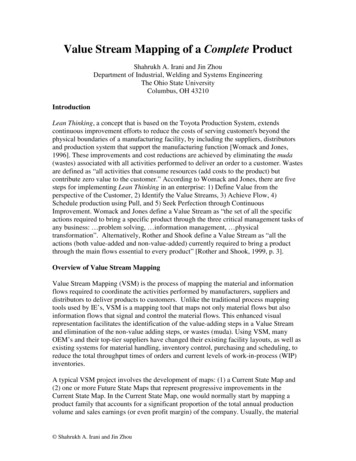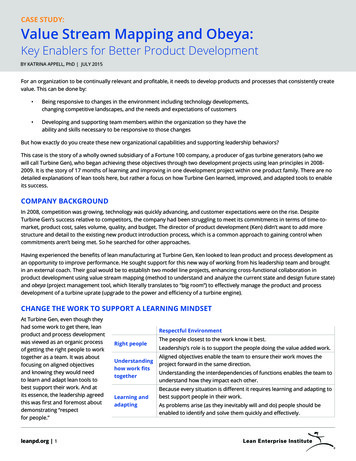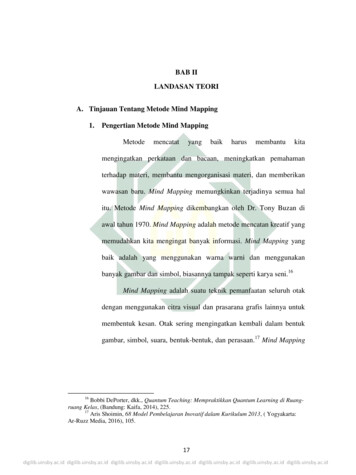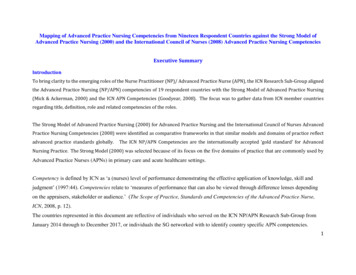
Transcription
Mapping of Advanced Practice Nursing Competencies from Nineteen Respondent Countries against the Strong Model ofAdvanced Practice Nursing (2000) and the International Council of Nurses (2008) Advanced Practice Nursing CompetenciesExecutive SummaryIntroductionTo bring clarity to the emerging roles of the Nurse Practitioner (NP)/ Advanced Practice Nurse (APN), the ICN Research Sub-Group alignedthe Advanced Practice Nursing (NP/APN) competencies of 19 respondent countries with the Strong Model of Advanced Practice Nursing(Mick & Ackerman, 2000) and the ICN APN Competencies (Goodyear, 2008). The focus was to gather data from ICN member countriesregarding title, definition, role and related competencies of the roles.The Strong Model of Advanced Practice Nursing (2000) for Advanced Practice Nursing and the International Council of Nurses AdvancedPractice Nursing Competencies (2008) were identified as comparative frameworks in that similar models and domains of practice reflectadvanced practice standards globally.The ICN NP/APN Competencies are the internationally accepted ‘gold standard’ for AdvancedNursing Practice. The Strong Model (2000) was selected because of its focus on the five domains of practice that are commonly used byAdvanced Practice Nurses (APNs) in primary care and acute healthcare settings.Competency is defined by ICN as ‘a (nurses) level of performance demonstrating the effective application of knowledge, skill andjudgment’ (1997:44). Competencies relate to ‘measures of performance that can also be viewed through difference lenses dependingon the appraisers, stakeholder or audience.’ (The Scope of Practice, Standards and Competencies of the Advanced Practice Nurse,ICN, 2008, p. 12).The countries represented in this document are reflective of individuals who served on the ICN NP/APN Research Sub-Group fromJanuary 2014 through to December 2017, or individuals the SG networked with to identify country specific APN competencies.1
Although many countries have advanced practice roles, only nineteen countries were able to make their country-specific competenciesavailable to the project.Background and PurposeIn line with the research focus of the ICN NP/APNN Research Sub-Group (SG): ‘to gather, analyse and report data on the development ofthe APN role worldwide’ (http://icn-apnetwork.org/), SG members participating in the May 2013 ICN International Congress inMelbourne (Australia), recognized the diversity of the scope of practice, clinical roles, practice settings and formal documentationsupporting the extended practice competencies of NPs and APNs internationally. Specifically, this discussion focused on role definitionin the context of clinical competencies.Dr. Rosemary Goodyear and her committee were instrumental in developing ‘The Scope of Practice, Standards and Competencies ofAdvanced Practice Nurse”, published by ICN in 2008.The Research Sub-Group was composed of the following members over the period of data collection: Co-Chairs: Lorna Schumann (USA) 2013-2017; Beverley Bird (Australia) 2012 -2017; Noriyo Colley (Japan) 2017 Members: Cynthia Pilane (Botswana), Elsie Duff (Canada), Franziska Geese (Switzerland, Republic of Ireland), Monika Jelic(USA), Internet source (Macao), Annie Topping (England and Qatar), Miho Suzuki (Japan), Noriyo Colley (Japan), PedroSastre-Fullana (Spain), Lisbeth Fagerstrom, Liaison, (Norway and Finland), 2013 to 2017, Bernadette Rae (England), DeborahGray (USA).Research Design and MethodsResearch DesignThe aim of this research was to align country specific (N 19) NP/APN competencies with the Strong Model of Advanced Practice Nursing(Mick & Ackerman, 2000) and the Scope of Practice, Standards and Competencies of the Advanced Practice Nurse (ICN 2008).2
The Research Sub-Group Co-Chairs developed a proposal for submission to the ICN NP/APN Core Steering Group (CSG) for review andEthics approval. Following CSG project approval, Research SG members commenced data collection in 2014 and concluded this process inlate 2017. This process included gathering role descriptions, standards of practice, and clinical competency documentation from publishedliterature and formal Nursing Boards and Ministries of Health Websites. Data was also obtained from a convenience sample of ICN NP/APNmembers and contacts through networking at international nursing conferences.Participant RecruitmentResearch SG members contributed NP/ANP competency data from the nursing jurisdictions within their own country and countries wherethey had established and reliable academic/ regulatory relationships (January 2014 – December 2017). ICN regulations in place duringthe competency mapping process prohibited implementation of a more comprehensive survey instrument distribution.Pertinent information was drawn from the following nineteen countries: Australia, Botswana, Canada, England, Finland, Germany, HongKong SAR-PRC, Japan, Macau-SAR-PRC, Netherlands, New Zealand, Norway, Republic of Ireland, Scotland, Singapore, Spain, Switzerland,United States of America, Wales.The Strong Model of Advanced Practice Nursing (2000)The Strong Model of Advanced Practice Nursing (2000) was used as the framework for this Competency document in that it had theability to adjust to a range of international communities with advanced practice nursing roles, including Advanced Certified NurseMidwives, Clinical Nurse Specialists, Nurse Practitioners and Nurse Anesthetists (Mick & Ackerman, 2000).The five domains of the model are: direct comprehensive care, education, support of systems, research, and publication and3
professional leadership. Although the Strong Model of Advanced Practice was originally developed for use in the acute care setting, ithas been adapted to the primary care role. Benner’s (1982, 1984) concept of novice to expert in terms of role development forAdvanced Practice Nurses (APNs) was foundational to the Strong Model. Knowledge, skills, attitudes, and judgment increase as theAdvanced Practice Nurse moves from novice to expert.Direct comprehensive care includes a range of assessments and interventions performed by APNs, including history taking, physicalassessment, requesting and/or performing diagnostic studies, performing invasive procedures, interpreting clinical and laboratory data,prescribing medications and other therapies, and case management of complex, critically-ill patients (Sprong, 2013). Directcomprehensive care involves activities for both the patient and family, empowering them to make informed decisions about theirhealth care. NP/APN Direct Comprehensive Care activities include: 1. Conduct and document patient history and physicalexamination; 2. Assess psychosocial, cultural and religious factors affecting patient needs; 3. Make a medical (health care provider)diagnosis within specialty scope of practice and practice guidelines; 4. Identify and initiate required diagnostic test and procedures; 5.Gather and interpret assessment data to formulate plan of care; 6. Perform specialty-specific procedures; 7. Assess patient or familyresponse to therapy and modify plan of care on the basis of response; 8. Communicate plan of care and response to patient and family;9. Provide appropriate education to patient and family; 10. Document appropriately on patient record; 11. Serve as a consultant inimproving patient care and nursing practice on the basis of expertise in area of specialization; 12. Facilitate the process of ethicaldecision making in patient care; 13. Coordinate interdisciplinary plan for care of patients; 14. Collaborate with other services tooptimize patient’s health status; and 15. Facilitate efficient movement of patient(s) through the health care system.Domains that support the delivery of patient careEducation includes a variety of activities that focus on the education of patients, families, providers, students and public. This domain4
has six areas of focus: 1. Evaluate education programs and recommend revision, as needed; 2. Serve as a formal educator and clinicalpreceptor for nursing and medical students, staff and others; 3. Identify learning needs of various populations and contribute to thedevelopment of educational programs and resources; 4. Serve as informal educator to staff, while providing direct care activities; 5.Facilitate professional development of nursing staff (and other staff) through education; and 6. Provide appropriate patient and familyeducation. Support of systems incorporates indirect patient care activities that support the clinical setting or organization and serve toimprove the quality of care. These activities include consultation, participating or leading strategic planning, quality improvementinitiatives, establishing and evaluating standards of practice, precepting students, and promoting APN practice (Strong, 2000). Thisdomain has nine areas of focus: 1. Consult with others regarding conduct of projects or presentations; 2. Actively contribute tomedical center (clinics) and school(s) of nursing recruitment and retention activities; 3. Participate in strategic planning for the service,department, or hospital; 4. Provide direction for and participation in unit or service quality improvement programs; 5. Provideleadership and actively participate in the assessment, development, implementation, and evaluation of quality-improvement programsin collaboration with nursing leadership; 6. Provide leadership in the development, implementation, and evaluation of standards ofpractice, policies, and procedures; 7. Serve as a mentor; 8. Advocate for the role of the Advanced Practice Nurse (Acute and Primarycare Nurse Practitioner, Clinical Nurse Specialist, Nurse Anesthetist or Clinical Nurse Midwife); and 9. Serve as a spokesperson fornursing and the medical center (clinic or other site of practice) when interacting with other professionals, patients, families, and thepublic.Research is the domain that includes the conduct of scientific inquiry and incorporation of evidence-based practice intocomprehensive care. Research has six areas of focus: 1. Conduct and lead clinical investigations; 2. Participate in investigations tomonitor and improve quality of patient care practices; 3. Seek out potential funding sources to support investigations of clinical issuesor to fund program development; 4. Facilitate clinical research through collaboration with others in investigations, analyze practiceproblems to generate research questions, and enable access to clients and data; 5. Use research and integrate theory into practice and5
recommend policy changes on the basis of research; and 6. Engineer or design clinical information systems that make data availablefor future research.Publication and Professional Leadership incorporates a variety of activities that disseminate knowledge about the scope of the APNrole that leads to improved health outcomes; participation in professional organizations as a member or leader; influencing health andpublic policy, and publications. This domain has six areas of focus: 1. Disseminate nursing knowledge through presentation orpublication at local, regional, national and international levels; 2. Serve as a resource, leader, or committee member on boards andprofessional organizations; 3. Serve as a consultant to individuals and groups in the professional and lay communities and otherhospitals or institutions; 4. Represent nursing in institutional, governmental, and community forums focused on the educational needsof various populations; 5. Represent a professional nursing image at institutional, governmental, and community forums; and 6.Provide leadership in shaping public policy on health care.International Council of Nurses: The Scope of Practice, Standards and Competencies of the Advanced Practice Nurse (ICN/Goodyear 2008)The ICN APN Scope of Practice, Standards and Competencies for the Advanced Practice Nurse (APN) (2008) established anAdvanced Practice Nursing Framework, also structured around Domains (N 3), with each Domain supported by conceptualsubcategories that reflect the scope and intent of the advanced practice nursing role:Domain 1: Professional, ethical and legal practice of nurses; Domain 2: Care provision and management by nurses; and Domain 3:Professional, personal and quality development (p. 9).[This] ‘framework allows the supplement of new competencies that reflect the expanding scope of practice and provides adistinctive emphasis on patient care at this level of practice. The competencies identified in the generalist nurse position arecoherent and comprehensive while, at the same time, capable of accommodating the nuances of each nation’s cultural context.The strengths and measures found in this framework provide another rationale for adopting it as the underpinning structure for6
specifying the APN competencies. The framework is also relatively easy to adjust to the international nursing communities ofeducation, practice and regulation (p. 9 &11).AssumptionsA set of seven assumptions ‘support the framework of the competencies’ thus serving as the basis for the internationalapplicability of the ICN/ APN role within the Domain Framework (2008):‘All APNs: are practitioners of nursing providing safe and competent patient care; have their foundation in registered generalist nurse education; have roles which require formal education beyond the preparation of the generalist nurse; have roles of increased levels of competency that are measurable; have competencies which address the ethical, legal , care giving and professional development of the advanced practicerole; have competencies and standards which are periodically reviewed for maintaining currency in practice; and, are influenced by the global social, political, economic and technological milieu.’ (ICN, 2008, p. 11)Definitions: Domains, Competence and CompetencyAPN Practice Domains are defined as ‘groupings of concepts and activities that make up an area of practice that is common to eachnurse functioning in a defined role’ (ICN, 2008, p. 11).Competence is defined as ‘A measure of behavior and performance’ (ICN, 2008) and Competency as ‘A level of performancedemonstrating the effective application of knowledge, skill and judgement’ (ICN 1997:44; ICN, 2008, p.11) and CompetencyIdentification ‘as a means for interpreting the scope of practice of the APN’ within the supporting framework. (ICN, 2008, p.13).7
Domain 1: Professional, Ethical and Legal Practice incorporating the Domains of Accountability, Ethical Practice, and Legal Practice;Domain 2: Care Provision and Management incorporating both the Key Principles of Care within the elements of Health Promotion;Assessment, Planning, Implementation, Evaluation; Therapeutic Communication and Interpersonal Relationships; Leadership andManagement; Inter-professional Health Care; Delegation and Supervision, and Safe Environment;Domain 3: Professional, Personal and Quality Development set out within the Domains of Enhancement of the Profession;Quality Improvement; and Continuing Education (pp.19-20).The ICN (2008) document acknowledges that APN Standards, Education, Scope of Practice and Regulation vary internationally andeven within countries and jurisdictions. In summary, its stated purpose is to set to ‘provide a framework, competencies andstandards’, and broad based guidelines for advanced practice nurses and associated stakeholders in the global nursing communityto:‘develop the role within their own nation while meeting the established professional, authorized and regulatory standards andrequirements’ (ICN, 2008, p. 23).Findings/ResultsAdvanced Practice Nursing Competencies, together with role definitions and scope of practice, were sourced from nineteen countries:Australia, Botswana, Canada, England, Finland, Germany, Hong Kong – SAR – PRC, Republic of Ireland, Japan, Macau, Netherlands, NewZealand, Norway, Scotland, Singapore, Spain, Switzerland, United States of America, Wales. The respondent country competencies weremapped initially against the five Domains of the Strong Model (2000): Domain 1: Direct Comprehensive Care (15 competencies); Domain 2:Education (6 competencies); Domain 3: Support of Systems (9 competencies); Domain 4: Research 6 competencies); and Publication andProfessional Leadership (6 competencies). Additionally, competencies from the respondent countries were aligned with ICN APNCompetencies (Goodyear, 2008) sourced from the ICN website.Expert clinicians reviewed the competency mapping table and identified the following consistent themes.8
Summary of Emerging Themes/ Roles1. Independent Practice/ Autonomy2. Prescriptive Authority3. Prescribing Therapeutic Regimens4. Evidence-based Practice5. Maintaining Competency6. Client/Patient Advocacy7. Health Promotion8. Critical Thinking9. Education (patients, families, peers, community)10. Collaborative Practice/ Interprofessional Collaboration11. Consultations/Referrals12. Mentoring13. Team Building14. Leadership and Care-coordination15. Professional Accountability/Responsibility16. Quality Care17. Influences Health Care Policy9
ConclusionAll nineteen countries were well represented across the Strong Domains 1 – 4. Following a review of the NP/APN mapping table, itwas determined that Domain 5 of the Strong Model (2000) (Publication and Professional Leadership: Represent a professional imageat institutional and community forums) was less likely to form a documented component of the NP/APN role. The structure and lessquantifiable elements of the ICN (2008) framework’s, scope of practice. and identifiable standards limited the ability for a robustcomparative analysis of all items within the Strong Model Framework.Limitations and Recommendations for Further WorkLimitations of the research include:Limitation 1. Scope: The scope of the research, with respect to wider international access to NP/APNN competency documentationrepresents the main limitation of this research;Limitation 2. Research Subgroup Membership: Changes in the Research Subgroup committee membership and structure throughout thefour-year data collection process;Limitation 3. Process Limitations: The data collection process and report writing processes were undertaken by Subgroup members inaddition to their full time academic and clinical roles;Limitation 4. Time Constraints: The data collection process required a significant time commitment on a volunteer basis over a four-yearperiod; and,Limitation 5. The structure and specific criteria within some Scope of Practice, Standards and Competency items of the AdvancedPractice Nurse (ICN/ Goodyear 2008) limited a more robust comparison with Domains of the Strong / Mick & Ackerman (2000)Model Domains.10
Recommendations for Further WorkRecommendation 1: Publication of the findings from the competency mapping process in an appropriate refereed journal;Recommendation 2: Follow-up analyses of country specific NP/APN competences in line with revised ICN NP/APN competencies, whenthese are available; and,Recommendation 3: Modification of the competency mapping data, based on contemporary iterations of advanced practice roles.ReferencesAckerman, M.H., Norsen, L., Martin, B., Wiedrich, J. & Kirzman, H.J. (1996). Development of a model of practice.American Journal of Critical Care. 5, 68 – 73,Benner, P. (1982) From novice to expert. American Journal of Nursing. 82, 402- 407International Council of Nurses (2008). [Goodyear, R, Ed) The Scope of Practice, Standards and Competencies forthe Advanced Practice Nurse. ICN: Geneva.Mick & Ackerman (2000). Advanced practice nursing role delineation in acute and critical care: Application of theStrong Model of advanced practice. Heart & Lung; The Journal of Acute and Critical Care, 29 (3), 210 – 221.Sprong, J.A. (2013). Conceptualizations of advanced nursing practice. In: A.B Hamric, CM, Hanson, M. Tracy,E.T. O. Grady (Eds). Advance practice nursing: An integrative approach (pp. 34 – 66). Philadelphia: Elsevier.11
2014 - 2017: Advanced Practice Nursing Key Competencies by Respondent CountryAustralia (NP); Botswana (NP); Canada (NP, CNS); England (NP, CNS); Finland (CNS, NP); Germany (CNS); Hong KongSAR–PRC (CNS); Ireland (ANP, AMP); Japan (CNS); Macau, SAR–PRC (CNS); Netherlands (NP); New Zealand (NP, CNS);Norway (CNS); Scotland (NP, CNS); Singapore (APN); Spain (NP); Switzerland (CNS); United States of America (NP, CNM,CNS); Wales (NP, CNS).GENERAL COUNTRY INFORMATION**The following information was submitted by individual country representatives.AUSTRALIADefinition of NP (Australian Nursing and Midwifery Council document on National Competency Standards for the NursePractitioner)A nurse practitioner is a registered nurse educated and authorized to function autonomously and collaboratively in advanced andextended clinical role. The nurse practitioner role includes assessment and management of clients using nursing knowledge andskills and may include, but is not limited to the direct referral of patients to other health care professionals, prescribing medicationsand ordering diagnostic investigations.The nurse practitioner role is grounded in the nursing profession’s values, knowledge, theories and practice and provides innovativeand flexible health care delivery that complements other health care providers (NMBA, 2013).‘The nurse practitioner: standards (Standards) build on, and expand upon, those required of a registered nurse. When assuming thetitle and scope of practice of a nurse practitioner, the NP understands the changes in the scope of practice from that of a registerednurse, and the ways that these changes affect responsibilities and accountabilities. Fundamentally, a nurse practitioner providesnursing care within their regulated scope’.Nurse Practitioner attributes are clinically focused, and NP’s are capable in research, education and leadership (domains) asapplied to clinical care. (NMBA, 2014, p1.)12
The Nurse Practitioner Standards Framework (Australia) (NMBA, 2014)Standard 1: Dynamic practice that incorporates application of high-level knowledge and skills in extended practice across stable,unpredictable and complex situations;Standard 2: Professional efficacy whereby practice is structured in a nursing model and enhanced by autonomy and accountability;Standard 3: Clinical leadership that influences and progresses clinical care, policy and collaboration through all levels of healthservice. (3 Descriptive Statements)Standard 4: Evaluates outcomes and improves practice. (2 Descriptive WANA (NP/APN Competencies)1. Client Assessment including comprehensive history, examination and ordering diagnostic tests2. Making differential and final diagnosis3. Development and implementation of treatment plan, including drug prescriptions4. Collaborative practice through referrals and consultation with other stakeholders5. Ethical, accountable and professional responsibility6. Client education and advocacy7. Participation in policy formation, leadership and research utilizationThe purpose of the role is to provide direct nursing care services of a sufficient quality to complement, match and enhancespecialized medical services and to carry out advanced Clinical procedures essential in the delivery of comprehensive health careservices, on a 24-hour basis.13
BOTSWANA (NP/APN Competencies c/1/fac/13/dep/74/School-of-Nursing/Botswana Competencies provided by Dr. Cynthia PilaneCANADA (NP, CNS)Advanced nursing practice focuses on clinical practice, whether through a direct relationship with clients or through a supportiveand consultative role. Nurse educators, researchers and administrators must demonstrate competencies in advanced nursing practiceand must have clinical practice as a significant part of their role if they are to be considered as functioning within advanced nursingpractice. “The CNS is a registered nurse who holds a graduate degree in nursing and has a high level of expertise in a clinicalspecialty” (Canadian Nurses Association [CAN], 2016). “NPs are educated in both nursing theory and medical skills and possessthe knowledge and skills to autonomously diagnose, order and interpret diagnostic tests, prescribe treatment (including drugs) andperform specific procedures (within their legislate scope of practice”; CNA 2010).NP Framework Competencies/Domains:a) Professional role, responsibility & accountability; b) Health assessment & diagnosis; c) Therapeutic management; d) Healthpromotion & prevention of illness & injury.CNS Core Competencies/Domainsa) Clinical care competencies; b) system leadership; c) advancement of nursing practice; d) evaluation & research.14
Mick, D., & Ackerman, M. H. (2000). Advanced practice nursing role delineation in acute and critical care: Application ofthe Strong model of advanced practice. Heart & Lung: The Journal of Acute and Critical Care, 29(3), 210–221. https://doi.org/10.1067/mhl.2000.106936Canadian Nurses Association. (2014). Pan-Canadian core competencies for the clinical nurse specialist (pp. 1 – 13). Ottawa,ON: Author. Retrieved from https://cna-aiic.ca/ /media/cna/files/en/clinical nurse specialists convention handout e.pdfCanadian Nurses Association. (2010). Canadian nurse practitioner core competency framework (pp. 1 – 21). Ottawa: Author.Canadian Nurses Association. (2009). Advanced nursing practice: A nation framework (pp. 1–46). Ottawa, ON: Author.Retrieved from www.cna-aicc.ca http://www.cna-aicc.ca Mick, D., & Ackerman, M. H. (2002). Deconstructing the myth of the advanced practice blended role: Support for roledivergence. Heart & Lung: The Journal of Acute and Critical Care, 31(6), 393–398. https://doi.org/10.1067/mhl.2002.129444Canadian Competencies provided by Dr. Elsie DuffENGLAND (NP, CNS)ENGLAND: Advanced Level Nursing: A Position Statement Department Health 20101.1 Practice autonomously and are self-directed;1.8 Appropriately define the boundaries of their practice;2.3 Are resilient and determined and demonstrate leadership in contexts that are unfamiliar, complex and unpredictable;4.1 Actively seek and participate in peer review of their own practice.Royal College of Nursing Advanced Nurse Practitioners (ICN Competencies, 2012)Autonomous: free to make decisions about their own actions. Independent synonymous with self-employed.‘Nurse Practitioner’ and ‘Advanced Nurse Practitioner’ are not protected titles.15
The Royal College of Nursing (RCN) has created a database to recognize nurses working at the advanced level. “Credentialing isthe process of assessing the background and legitimacy of nurses to practice at an advanced level through assessing theirqualifications, experience and competence. Credentialing allows nurses to gain formal recognition of their level of expertise andskill in their clinical practice, their leadership, their education and their research in a way that is recognizable to colleagues,employers, patients and the public. Credentialing is open to nurse who can demonstrate that they ae working at an advanced level,practice in the NHS or independent sector and are either members or non-members of the RCN. Nurses will require a relevantmaster’s qualification, non-medical prescribing rights and an active membership of the Nursing and Midwifery Council (NMC) tocredential”.Nursing and Midwifery Council Standards of Proficiency for nurse and midwife prescribes (2006) is currently under review. Special thanks to Janet Marsden for materials from United Kingdom, Scotland and Wales.FINLAND (NP)Advanced practice nursing is carried out in Finland by Nurse Practitioners, Clinical Nurse Specialists and Registered Nurses withlimited prescribing rights (Kotila, Axelin, Fagerström et al. 2015).Nurse PractitionerScope of practice: Extensive and comprehensive nursing care, such as assessing the patient’s care needs independently byconducting health history and a systematic physical assessment, care and treatment of patient’s health problems and symptoms,health promotion and prevention, and initiation and follow-up of symptomatic treatment in both acute and chronic health problems.A Nurse Practitioner can independently diagnose, investigate, care and treat patients with acute or chronic health problems orillnesses. NP has medical expertise that extends their work in nursing. NP may have her/his own nursing clinic and is working inclose cooperation with the doctor.Education on master level is the recommendation. A registered nurse with an additional non-medical prescribing course (45 ECTS)16
is registered at the national board VALVIRA and will then have legal rights for limited prescribing in primary health care.Competency domains of Nurse Practitioner:1. Advanced clinical practice (health assessment and clinical decision making, therapeutic management, health promotion andprevention of acute and chronic health problems)2. Ethical decision making;3. Education, coaching and guidance;4. Consultation;5. Cooperation;6. Case management;7. Leadership;8. Research and development(published in Lisbeth Fagerström (2011): Advanced practice nurse-theory and practice. Studentlitteratur, Lund (In Swedish)Clinical Nurse SpecialistScope of practice: Extensive nursing care with the overall purpose to ensure and develop the quality of nursing, to promoteevidence-based nursing and to support the organization's strategic work.CNS is a clinical nursing expert and is responsible for developing the quality of nursing and implementing evidence-based nursing.CNS is a member of a multi-professional team, developing a wide range of nursing and organizational activities, and conductresearch and development.Education on master level is the recommendation.Competency domains of Clinical Nurse
To bring clarity to the emerging roles of the Nurse Practitioner (NP)/ Advanced Practice Nurse (APN), the ICN Research Sub-Group aligned the Advanced Practice Nursing (NP/APN) competencies of 19 respondent countries with the Strong Model of Advanced Practice Nursing (Mick & Ackerman, 2000) and the ICN APN Competencies (Goodyear, 2008).
